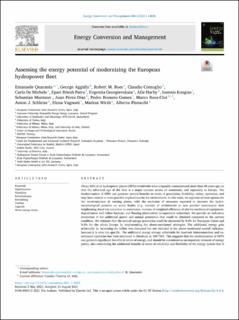| dc.description.abstract | About 50% of all hydropower plants (HPPs) worldwide were originally commissioned more than 40 years ago, so that the advanced age of the fleet is a major concern across all continents, and especially in Europe. The modernization of HPPs can generate several benefits in terms of generation, flexibility, safety, operation, and may have neutral or even positive implications for the environment. In this work, we appraise several options for the modernization of existing plants, with the exclusion of measures expected to increase the hydro-morphological pressure on water bodies (e.g. increase of withdrawals or new parallel waterways): dam heightening, head loss reduction in waterways, increase of weighted efficiency of electro-mechanical equipment, digitalization and inflow forecast, and floating photovoltaic (evaporation reduction). We provide an indicative estimation of the additional power and annual generation that could be obtained compared to the current condition. We estimate that the overall energy generation could be increased by 8.4% for European Union and 9.4% for the whole Europe by implementing the above-mentioned strategies. The additional energy gain achievable by increasing the inflow was discussed but not included in the above mentioned overall indicator, because it is very site-specific. The additional energy storage achievable by reservoir interconnection and coordinated operation has been estimated in literature as 169 TWh. This suggests that the modernization of HPPs can generate significant benefits in terms of energy, and should be considered as an important element of energy policy, also considering the additional benefits in terms of reliability and flexibility of the energy system that it may deliver. The modernization options considered here, insofar as not entailing a worsening of the hydro-morphological alterations, are also expected to cause limited or no conflict with the environmental objectives of water policies in Europe. | en_US |

